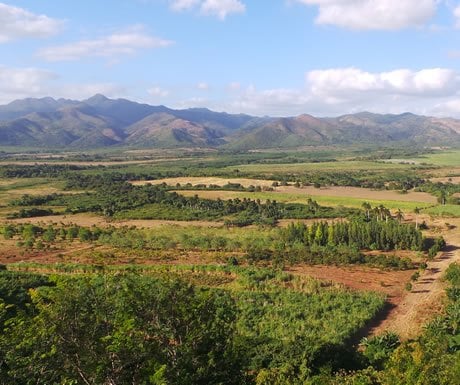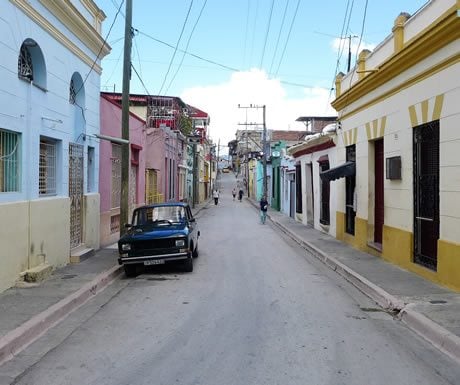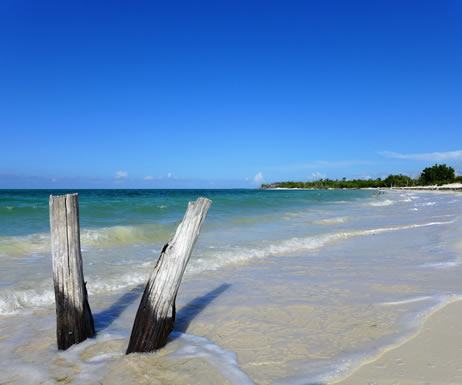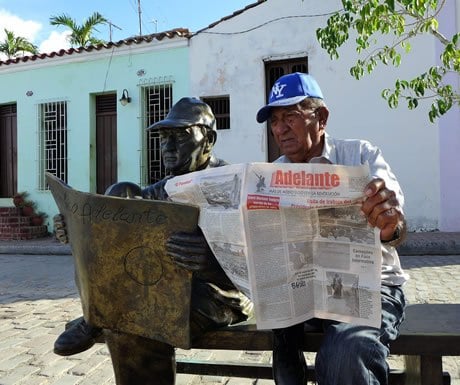Attractions · Caribbean · Cuba · Going Out · Regions
Top 5 highlights of Cuba, beyond Havana
Thought it may seem dwarfed by its greatest frenemy, the USA, Cuba is deceptively large. It takes around 12 hours to drive from Havana to the second city, Santiago de Cuba, on the islands southernmost coast. Fortunately for anyone looking to explore beyond the capital, internal flights are becoming increasingly available, making hitherto far-flung towns and cities more accessible. And while Havana is an intoxicating place to soak up Cubano music, architecture and the rhythms of daily life, its only part of the picture. Our specialists have been arguing passionately over the best places to explore outside of Havana: heres their shortlist.
Trinidad and the Valle de los Ingenios
A showpiece for Baroque architecture and the best preserved colonial city in Cuba, theres a lot more to the mansions and red tiles of Trinidad than meets the eye.
 Once you have had your fill of salsa in one of the towns plentiful and excellent casas de la trova (music halls), take a trip to the nearby Valle de los Ingenios (Valley of the Sugar Mills). Now a placid-seeming expanse of palms and the remains of sugar cane plantations, in the 19th century this was an area teeming with slaves toiling in the industry that made Trinidad so wealthy, and financed its gilded dwellings.
With so much of Cubas history taken up by Castro and communism, its easy to forget its complicity in the slave trade, but a guided tour of the valley can bring it viscerally back to life. Youll see the skeletons of watchtowers overlooking the fields, and derelict barrancos huts where slaves lived.
Viñales
Another glimpse of rural Cuba, but without the dark backstory of the Valle de los Ingenios: Viñales is a long, flat valley cloaked in tropical vegetation and tobacco plantations. Its also punctuated seemingly at random by curved limestone outcrops, called mogotes.
Once you have had your fill of salsa in one of the towns plentiful and excellent casas de la trova (music halls), take a trip to the nearby Valle de los Ingenios (Valley of the Sugar Mills). Now a placid-seeming expanse of palms and the remains of sugar cane plantations, in the 19th century this was an area teeming with slaves toiling in the industry that made Trinidad so wealthy, and financed its gilded dwellings.
With so much of Cubas history taken up by Castro and communism, its easy to forget its complicity in the slave trade, but a guided tour of the valley can bring it viscerally back to life. Youll see the skeletons of watchtowers overlooking the fields, and derelict barrancos huts where slaves lived.
Viñales
Another glimpse of rural Cuba, but without the dark backstory of the Valle de los Ingenios: Viñales is a long, flat valley cloaked in tropical vegetation and tobacco plantations. Its also punctuated seemingly at random by curved limestone outcrops, called mogotes.
 A visit here can be anything from a sedate getaway or an adventure playground. You could spend a day rambling along the valley floor, perhaps stopping to visit working tobacco plantations and watch nimble-fingered farmers roll you a homemade cigar. Alternatively, theres one of the largest cave systems in Latin America to explore, more challenging hiking trails, horseback riding, or several cycle tracks.
Many visitors choose to experience a traditional cigar factory in Havana, but its possible to see one during your stay in Viñales, too. A guide can take you around the Pinar del Rio factory, a 45-minute drive away. He/she will explain about customs including the role of the lector, whose job was to read educational texts aloud to workers.
Santiago de Cuba
The former capital, Santiago de Cuba is Havana, only with the heat, noise, music and attitude tuned up a notch. Its a city of peeling pastel buildings that pounds with conga (an African music style with a powerful beat), trova and other rhythms. The descendants of slaves, the citys Afro-Caribbean community has sculpted the city, from the music heard in bars and on the street, to the syncretic religion of Santería. Walking around, you can identify adherents by their white clothing and kaleidoscopic beads.
A visit here can be anything from a sedate getaway or an adventure playground. You could spend a day rambling along the valley floor, perhaps stopping to visit working tobacco plantations and watch nimble-fingered farmers roll you a homemade cigar. Alternatively, theres one of the largest cave systems in Latin America to explore, more challenging hiking trails, horseback riding, or several cycle tracks.
Many visitors choose to experience a traditional cigar factory in Havana, but its possible to see one during your stay in Viñales, too. A guide can take you around the Pinar del Rio factory, a 45-minute drive away. He/she will explain about customs including the role of the lector, whose job was to read educational texts aloud to workers.
Santiago de Cuba
The former capital, Santiago de Cuba is Havana, only with the heat, noise, music and attitude tuned up a notch. Its a city of peeling pastel buildings that pounds with conga (an African music style with a powerful beat), trova and other rhythms. The descendants of slaves, the citys Afro-Caribbean community has sculpted the city, from the music heard in bars and on the street, to the syncretic religion of Santería. Walking around, you can identify adherents by their white clothing and kaleidoscopic beads.
 Its also a city thats witnessed much history. Fidel Castro spearheaded the revolution here by attacking a barracks, and hid out for six months in the nearby Sierra Maestra mountain range with the revolutionary army. More recently, the city hosted his funeral, when busloads of people came in from surrounding towns and villages to mourn and pay their respects.
Cayo Levisa
If youre looking for a more authentically Cuban beach retreat, shun the all-inclusive resorts of Varadero and catch the boat out to this white-sand cay on the countrys north coast. Its accessible from Viñales as well as Havana, and setting foot on it feels like a total escape from both the all-pervading greenery of Viñales and the humid streets of the capital.
Its also a city thats witnessed much history. Fidel Castro spearheaded the revolution here by attacking a barracks, and hid out for six months in the nearby Sierra Maestra mountain range with the revolutionary army. More recently, the city hosted his funeral, when busloads of people came in from surrounding towns and villages to mourn and pay their respects.
Cayo Levisa
If youre looking for a more authentically Cuban beach retreat, shun the all-inclusive resorts of Varadero and catch the boat out to this white-sand cay on the countrys north coast. Its accessible from Viñales as well as Havana, and setting foot on it feels like a total escape from both the all-pervading greenery of Viñales and the humid streets of the capital.
 Theres only one small hotel made up of rustic cabañas (beach huts), and theres blissfully little to do apart from stare out to the aquamarine sea, snorkel, and relax. The more energetic can walk across the islet through tangled mangroves to reach footprint-free stretches of sand, keeping an eye out for jutias (beaver-like rodents endemic to Cuba).
Camagüey
Located almost bang in the middle of the country, this is a town of cobblestone dead-end streets (designed, allegedly, to confuse unwelcome pirates) and half-restored, half-dilapidated buildings. Few visitors see it as little more than a stopover en route to eastern Cuba, but theres much more to it than that. Camagüey is studded with art.
Theres only one small hotel made up of rustic cabañas (beach huts), and theres blissfully little to do apart from stare out to the aquamarine sea, snorkel, and relax. The more energetic can walk across the islet through tangled mangroves to reach footprint-free stretches of sand, keeping an eye out for jutias (beaver-like rodents endemic to Cuba).
Camagüey
Located almost bang in the middle of the country, this is a town of cobblestone dead-end streets (designed, allegedly, to confuse unwelcome pirates) and half-restored, half-dilapidated buildings. Few visitors see it as little more than a stopover en route to eastern Cuba, but theres much more to it than that. Camagüey is studded with art.
 Beyond its ubiquitous tinajones (clay pots used to store rainwater), in the main square and throughout the town, youll find bronze sculptures of citizens. They come in all shapes and sizes, from a man perched on a bench, reading a newspaper, to a trio of housewives named The Gossipers. Theyre the creations of local artist Marta Jimenez, who opens up her studio to visitors interested in her work.
The town is also home to an internationally known classical violinist (shell give short private performances, on request) as well as a grand and much-loved theatre.
Craig Burkinshaw is Founder of Audley Travel.
If you would like to be a guest blogger on A Luxury Travel Blog in order to raise your profile, please contact us.
Beyond its ubiquitous tinajones (clay pots used to store rainwater), in the main square and throughout the town, youll find bronze sculptures of citizens. They come in all shapes and sizes, from a man perched on a bench, reading a newspaper, to a trio of housewives named The Gossipers. Theyre the creations of local artist Marta Jimenez, who opens up her studio to visitors interested in her work.
The town is also home to an internationally known classical violinist (shell give short private performances, on request) as well as a grand and much-loved theatre.
Craig Burkinshaw is Founder of Audley Travel.
If you would like to be a guest blogger on A Luxury Travel Blog in order to raise your profile, please contact us.
 Once you have had your fill of salsa in one of the towns plentiful and excellent casas de la trova (music halls), take a trip to the nearby Valle de los Ingenios (Valley of the Sugar Mills). Now a placid-seeming expanse of palms and the remains of sugar cane plantations, in the 19th century this was an area teeming with slaves toiling in the industry that made Trinidad so wealthy, and financed its gilded dwellings.
With so much of Cubas history taken up by Castro and communism, its easy to forget its complicity in the slave trade, but a guided tour of the valley can bring it viscerally back to life. Youll see the skeletons of watchtowers overlooking the fields, and derelict barrancos huts where slaves lived.
Viñales
Another glimpse of rural Cuba, but without the dark backstory of the Valle de los Ingenios: Viñales is a long, flat valley cloaked in tropical vegetation and tobacco plantations. Its also punctuated seemingly at random by curved limestone outcrops, called mogotes.
Once you have had your fill of salsa in one of the towns plentiful and excellent casas de la trova (music halls), take a trip to the nearby Valle de los Ingenios (Valley of the Sugar Mills). Now a placid-seeming expanse of palms and the remains of sugar cane plantations, in the 19th century this was an area teeming with slaves toiling in the industry that made Trinidad so wealthy, and financed its gilded dwellings.
With so much of Cubas history taken up by Castro and communism, its easy to forget its complicity in the slave trade, but a guided tour of the valley can bring it viscerally back to life. Youll see the skeletons of watchtowers overlooking the fields, and derelict barrancos huts where slaves lived.
Viñales
Another glimpse of rural Cuba, but without the dark backstory of the Valle de los Ingenios: Viñales is a long, flat valley cloaked in tropical vegetation and tobacco plantations. Its also punctuated seemingly at random by curved limestone outcrops, called mogotes.
 A visit here can be anything from a sedate getaway or an adventure playground. You could spend a day rambling along the valley floor, perhaps stopping to visit working tobacco plantations and watch nimble-fingered farmers roll you a homemade cigar. Alternatively, theres one of the largest cave systems in Latin America to explore, more challenging hiking trails, horseback riding, or several cycle tracks.
Many visitors choose to experience a traditional cigar factory in Havana, but its possible to see one during your stay in Viñales, too. A guide can take you around the Pinar del Rio factory, a 45-minute drive away. He/she will explain about customs including the role of the lector, whose job was to read educational texts aloud to workers.
Santiago de Cuba
The former capital, Santiago de Cuba is Havana, only with the heat, noise, music and attitude tuned up a notch. Its a city of peeling pastel buildings that pounds with conga (an African music style with a powerful beat), trova and other rhythms. The descendants of slaves, the citys Afro-Caribbean community has sculpted the city, from the music heard in bars and on the street, to the syncretic religion of Santería. Walking around, you can identify adherents by their white clothing and kaleidoscopic beads.
A visit here can be anything from a sedate getaway or an adventure playground. You could spend a day rambling along the valley floor, perhaps stopping to visit working tobacco plantations and watch nimble-fingered farmers roll you a homemade cigar. Alternatively, theres one of the largest cave systems in Latin America to explore, more challenging hiking trails, horseback riding, or several cycle tracks.
Many visitors choose to experience a traditional cigar factory in Havana, but its possible to see one during your stay in Viñales, too. A guide can take you around the Pinar del Rio factory, a 45-minute drive away. He/she will explain about customs including the role of the lector, whose job was to read educational texts aloud to workers.
Santiago de Cuba
The former capital, Santiago de Cuba is Havana, only with the heat, noise, music and attitude tuned up a notch. Its a city of peeling pastel buildings that pounds with conga (an African music style with a powerful beat), trova and other rhythms. The descendants of slaves, the citys Afro-Caribbean community has sculpted the city, from the music heard in bars and on the street, to the syncretic religion of Santería. Walking around, you can identify adherents by their white clothing and kaleidoscopic beads.
 Its also a city thats witnessed much history. Fidel Castro spearheaded the revolution here by attacking a barracks, and hid out for six months in the nearby Sierra Maestra mountain range with the revolutionary army. More recently, the city hosted his funeral, when busloads of people came in from surrounding towns and villages to mourn and pay their respects.
Cayo Levisa
If youre looking for a more authentically Cuban beach retreat, shun the all-inclusive resorts of Varadero and catch the boat out to this white-sand cay on the countrys north coast. Its accessible from Viñales as well as Havana, and setting foot on it feels like a total escape from both the all-pervading greenery of Viñales and the humid streets of the capital.
Its also a city thats witnessed much history. Fidel Castro spearheaded the revolution here by attacking a barracks, and hid out for six months in the nearby Sierra Maestra mountain range with the revolutionary army. More recently, the city hosted his funeral, when busloads of people came in from surrounding towns and villages to mourn and pay their respects.
Cayo Levisa
If youre looking for a more authentically Cuban beach retreat, shun the all-inclusive resorts of Varadero and catch the boat out to this white-sand cay on the countrys north coast. Its accessible from Viñales as well as Havana, and setting foot on it feels like a total escape from both the all-pervading greenery of Viñales and the humid streets of the capital.
 Theres only one small hotel made up of rustic cabañas (beach huts), and theres blissfully little to do apart from stare out to the aquamarine sea, snorkel, and relax. The more energetic can walk across the islet through tangled mangroves to reach footprint-free stretches of sand, keeping an eye out for jutias (beaver-like rodents endemic to Cuba).
Camagüey
Located almost bang in the middle of the country, this is a town of cobblestone dead-end streets (designed, allegedly, to confuse unwelcome pirates) and half-restored, half-dilapidated buildings. Few visitors see it as little more than a stopover en route to eastern Cuba, but theres much more to it than that. Camagüey is studded with art.
Theres only one small hotel made up of rustic cabañas (beach huts), and theres blissfully little to do apart from stare out to the aquamarine sea, snorkel, and relax. The more energetic can walk across the islet through tangled mangroves to reach footprint-free stretches of sand, keeping an eye out for jutias (beaver-like rodents endemic to Cuba).
Camagüey
Located almost bang in the middle of the country, this is a town of cobblestone dead-end streets (designed, allegedly, to confuse unwelcome pirates) and half-restored, half-dilapidated buildings. Few visitors see it as little more than a stopover en route to eastern Cuba, but theres much more to it than that. Camagüey is studded with art.
 Beyond its ubiquitous tinajones (clay pots used to store rainwater), in the main square and throughout the town, youll find bronze sculptures of citizens. They come in all shapes and sizes, from a man perched on a bench, reading a newspaper, to a trio of housewives named The Gossipers. Theyre the creations of local artist Marta Jimenez, who opens up her studio to visitors interested in her work.
The town is also home to an internationally known classical violinist (shell give short private performances, on request) as well as a grand and much-loved theatre.
Craig Burkinshaw is Founder of Audley Travel.
If you would like to be a guest blogger on A Luxury Travel Blog in order to raise your profile, please contact us.
Beyond its ubiquitous tinajones (clay pots used to store rainwater), in the main square and throughout the town, youll find bronze sculptures of citizens. They come in all shapes and sizes, from a man perched on a bench, reading a newspaper, to a trio of housewives named The Gossipers. Theyre the creations of local artist Marta Jimenez, who opens up her studio to visitors interested in her work.
The town is also home to an internationally known classical violinist (shell give short private performances, on request) as well as a grand and much-loved theatre.
Craig Burkinshaw is Founder of Audley Travel.
If you would like to be a guest blogger on A Luxury Travel Blog in order to raise your profile, please contact us.Did you enjoy this article?
Receive similar content direct to your inbox.

